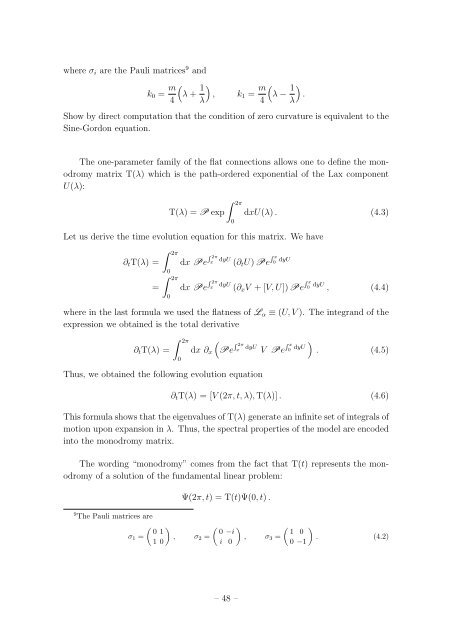Student Seminar: Classical and Quantum Integrable Systems
Student Seminar: Classical and Quantum Integrable Systems
Student Seminar: Classical and Quantum Integrable Systems
You also want an ePaper? Increase the reach of your titles
YUMPU automatically turns print PDFs into web optimized ePapers that Google loves.
where σ i are the Pauli matrices 9 <strong>and</strong><br />
k 0 = m 4<br />
(<br />
λ + 1 )<br />
, k 1 = m (<br />
λ − 1 )<br />
.<br />
λ<br />
4 λ<br />
Show by direct computation that the condition of zero curvature is equivalent to the<br />
Sine-Gordon equation.<br />
The one-parameter family of the flat connections allows one to define the monodromy<br />
matrix T(λ) which is the path-ordered exponential of the Lax component<br />
U(λ):<br />
∫ 2π<br />
T(λ) = P exp dxU(λ) . (4.3)<br />
0<br />
Let us derive the time evolution equation for this matrix. We have<br />
∂ t T(λ) =<br />
=<br />
∫ 2π<br />
0<br />
∫ 2π<br />
0<br />
dx Pe R 2π<br />
x dyU (∂ t U) Pe R x<br />
0 dyU<br />
dx Pe R 2π<br />
x dyU (∂ x V + [V, U]) Pe R x<br />
0 dyU , (4.4)<br />
where in the last formula we used the flatness of L α ≡ (U, V ). The integr<strong>and</strong> of the<br />
expression we obtained is the total derivative<br />
∂ t T(λ) =<br />
∫ 2π<br />
0<br />
(<br />
dx ∂ x Pe R 2π<br />
x<br />
Thus, we obtained the following evolution equation<br />
dyU V Pe R x<br />
0 dyU )<br />
. (4.5)<br />
∂ t T(λ) = [V (2π, t, λ), T(λ)] . (4.6)<br />
This formula shows that the eigenvalues of T(λ) generate an infinite set of integrals of<br />
motion upon expansion in λ. Thus, the spectral properties of the model are encoded<br />
into the monodromy matrix.<br />
The wording “monodromy” comes from the fact that T(t) represents the monodromy<br />
of a solution of the fundamental linear problem:<br />
9 The Pauli matrices are<br />
σ 1 =<br />
( ) 0 1<br />
, σ 2 =<br />
1 0<br />
Ψ(2π, t) = T(t)Ψ(0, t) .<br />
( )<br />
( )<br />
0 −i<br />
1 0<br />
, σ 3 = . (4.2)<br />
i 0<br />
0 −1<br />
– 48 –

















